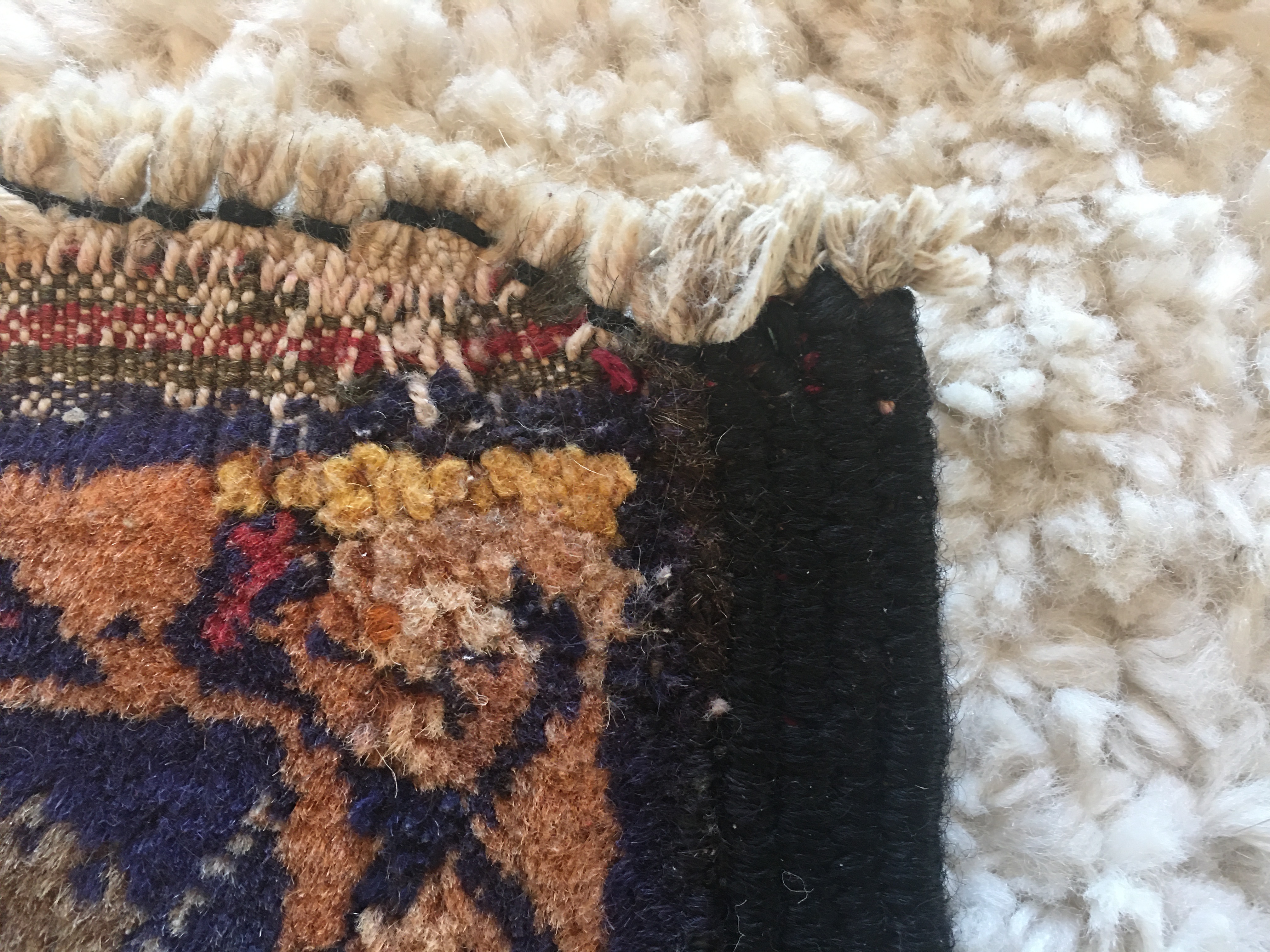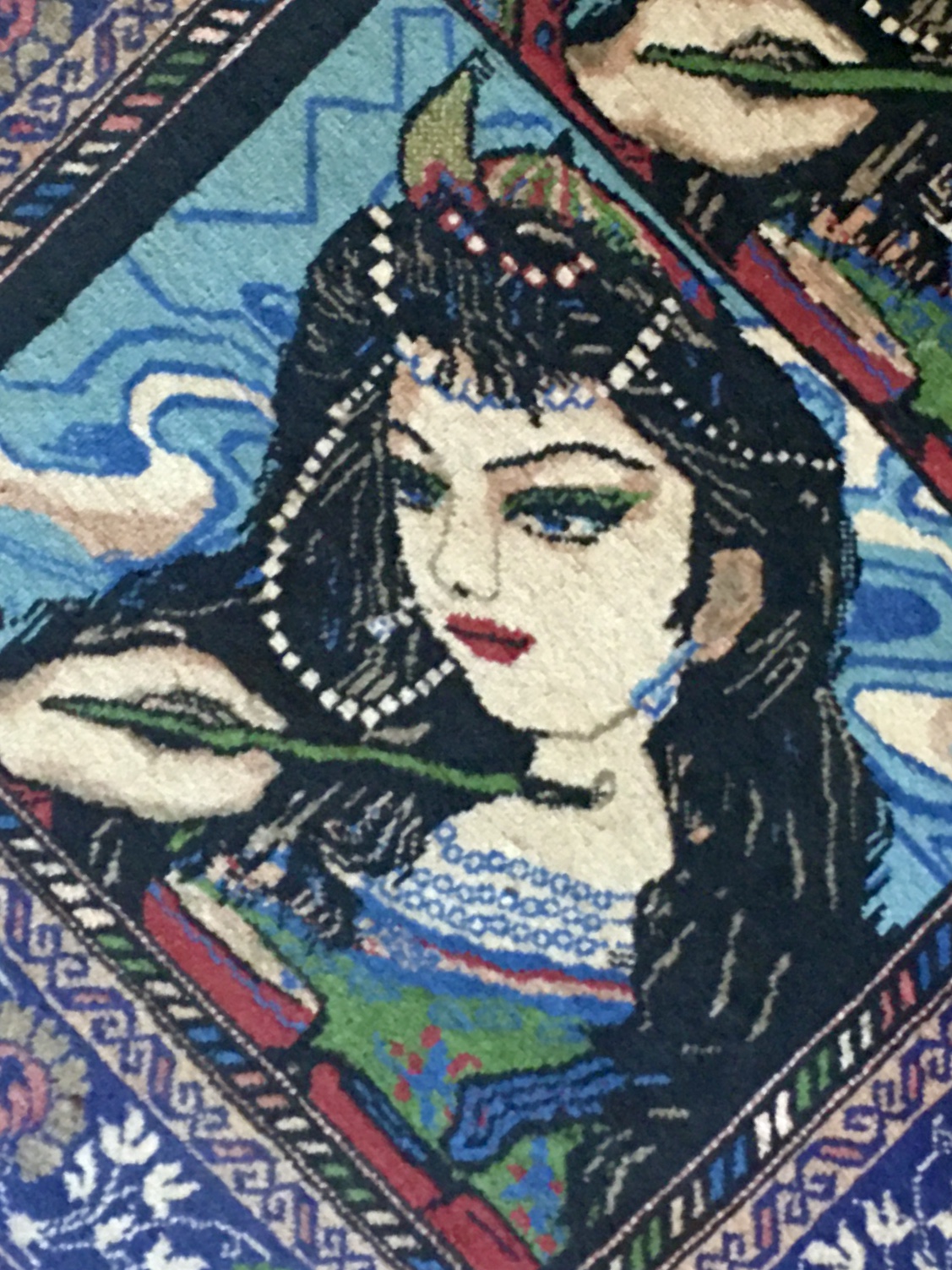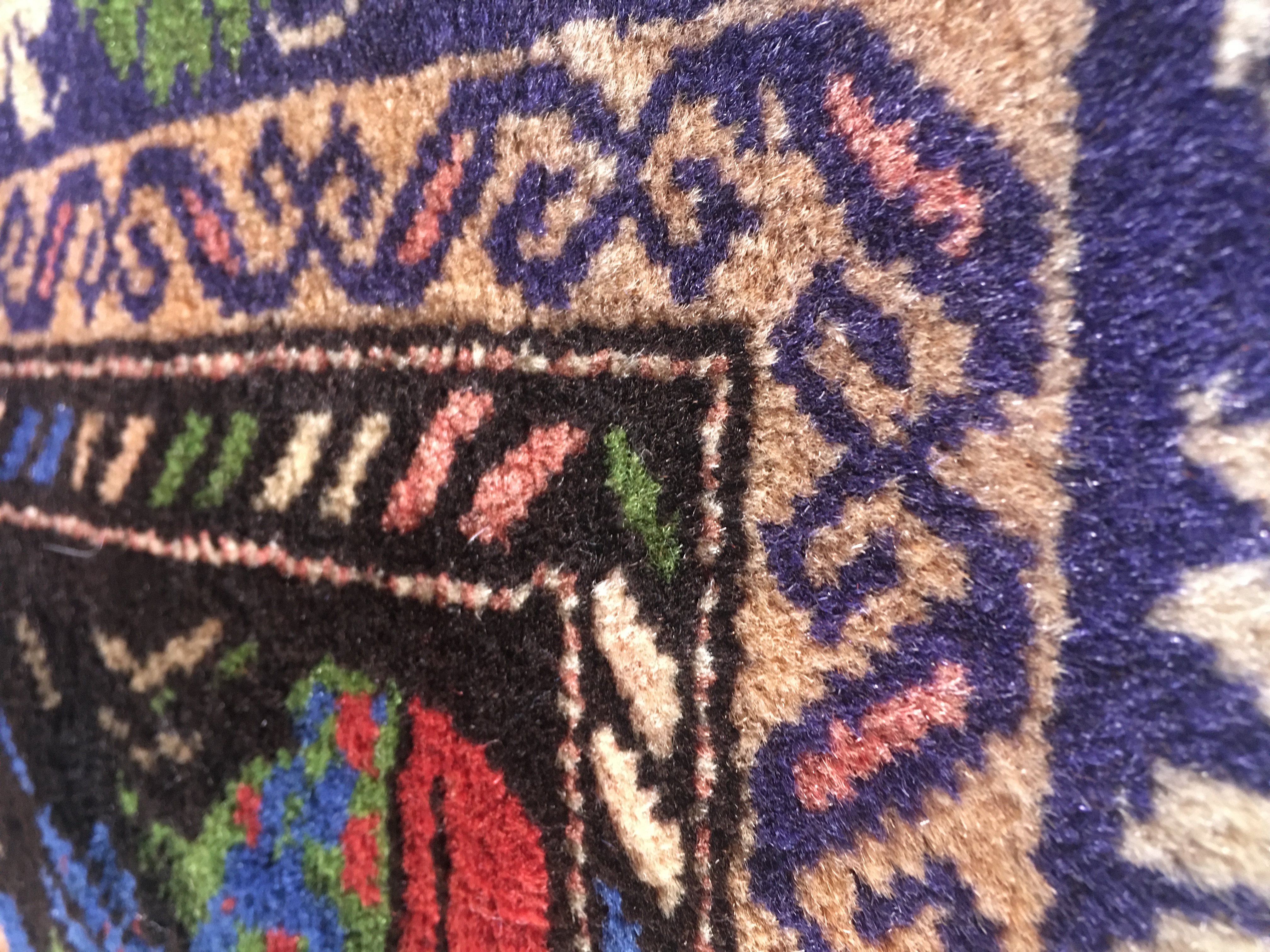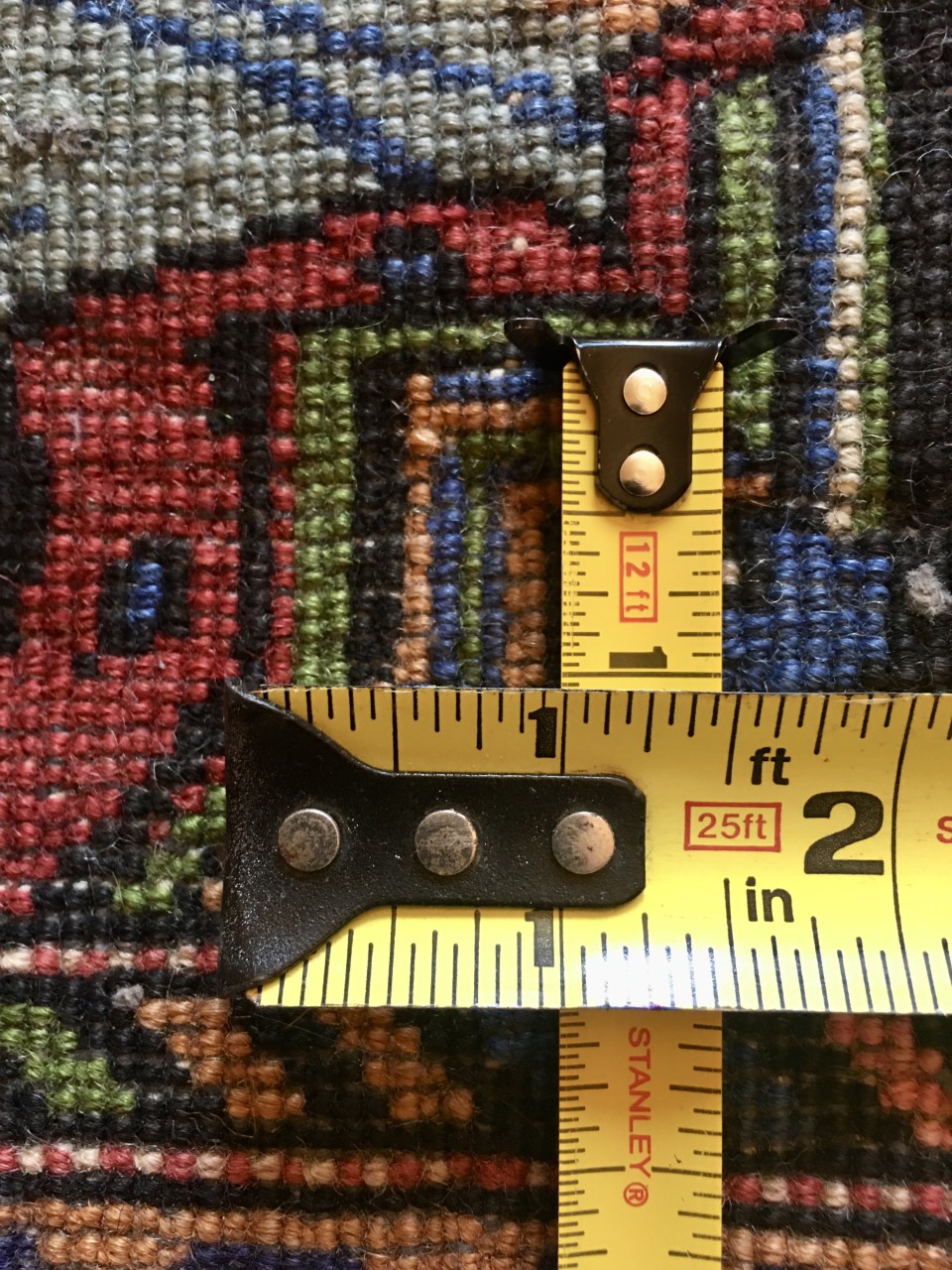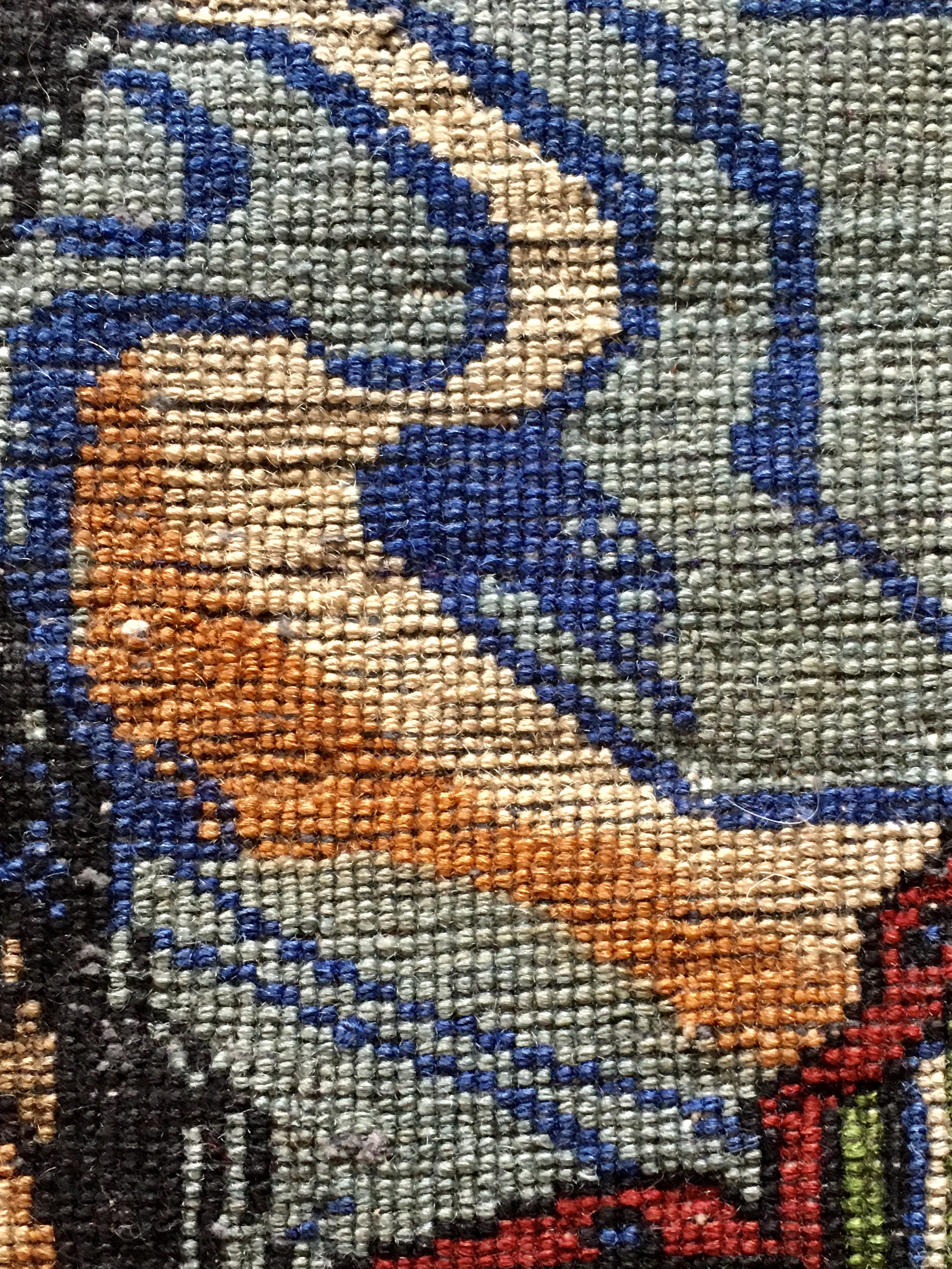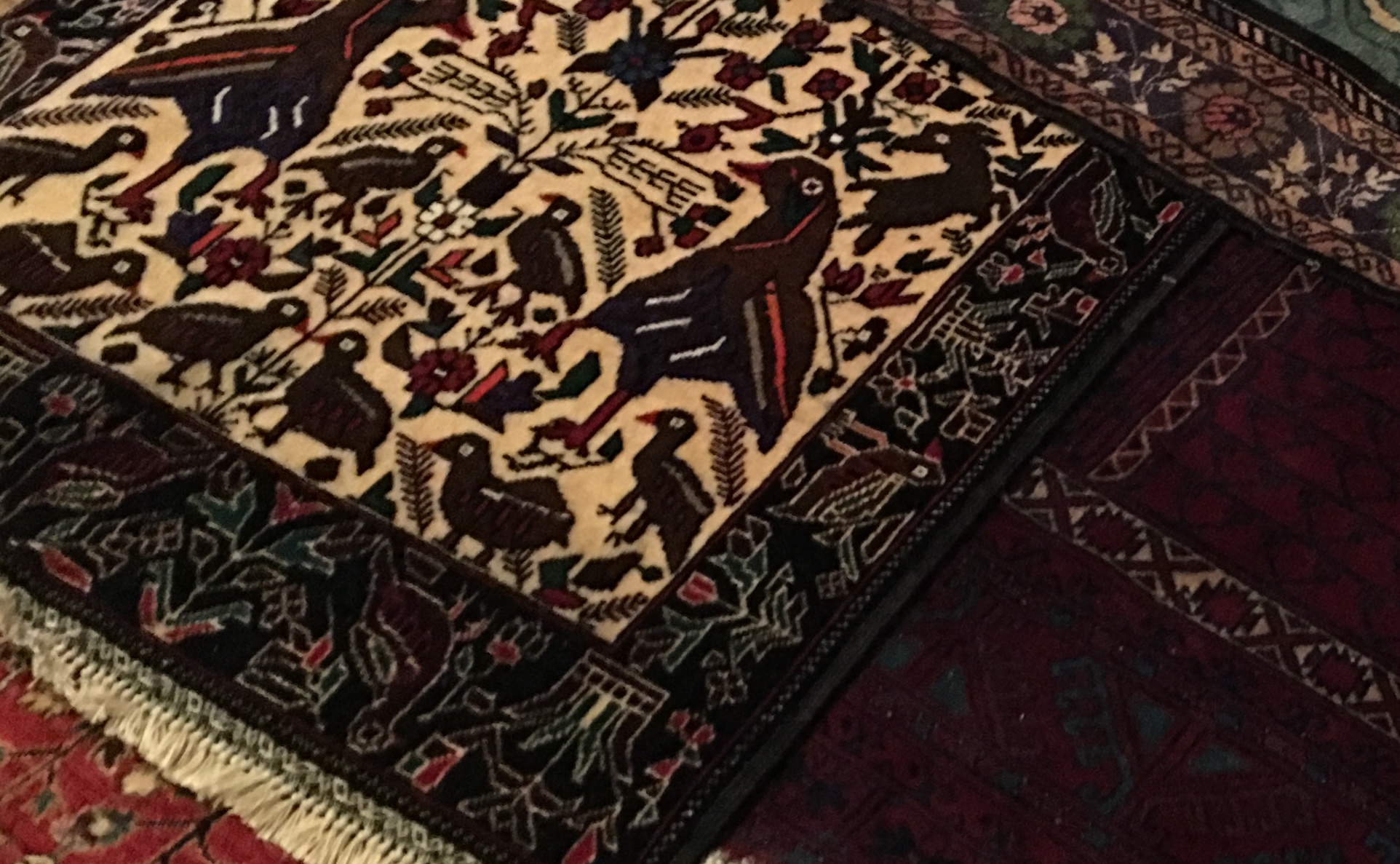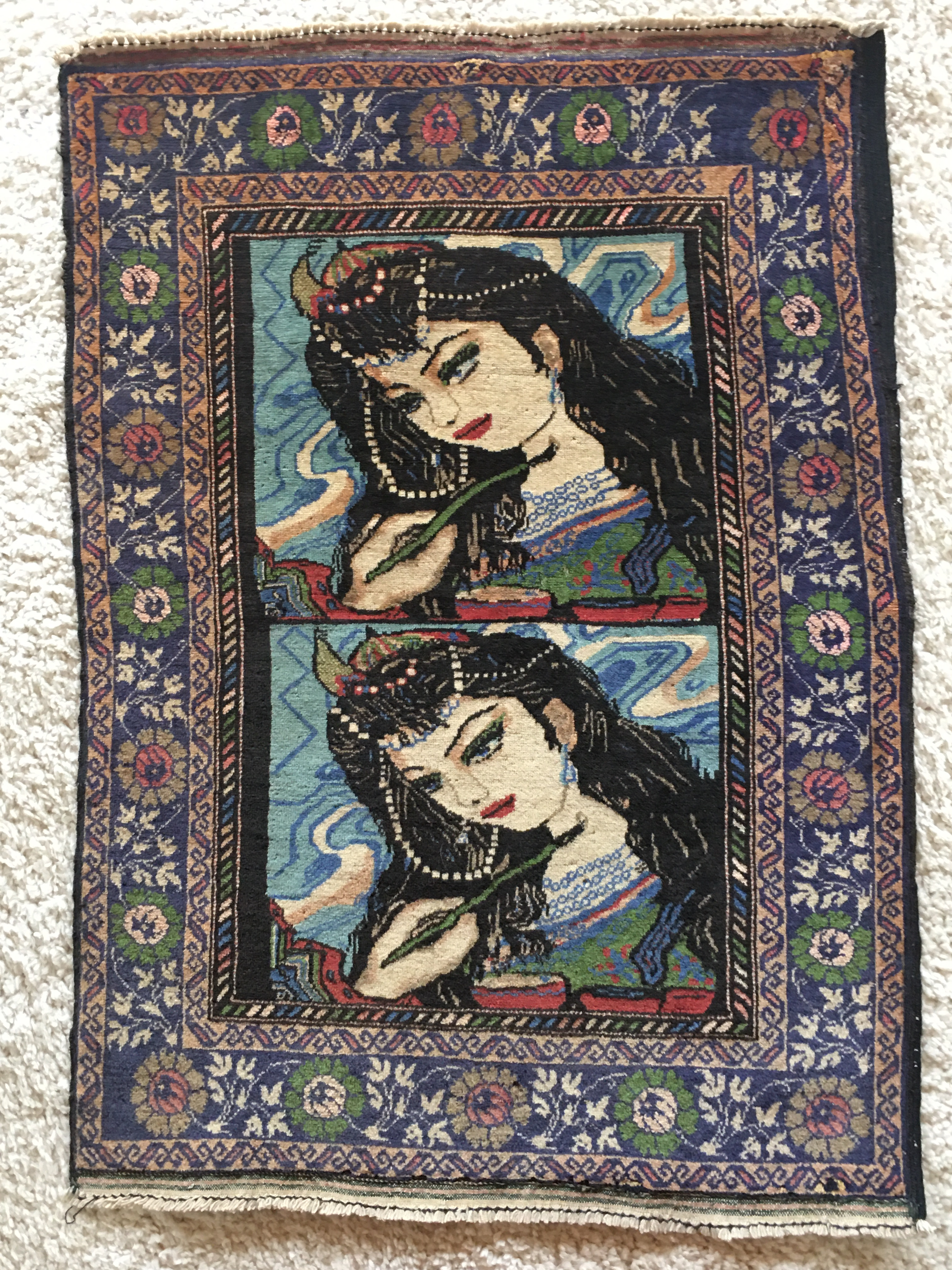
Reading for the Weaver
Amplifying Agency through a Material Rhetoric Methodology
Nancy Small with Riyaz Bhat
The Shirin Rug
A Sample Reading

This page applies the textile reading framework to the Shirin rug, a carpet that Riyaz initially lent me as I was working on this project but that now resides with me. Despite our current proximities, the weaver of this rug and I are separated by time (approximately 40 years), space (approximately 7,100 miles), and cultures/communities. The application of the framework relies on what I learned about Central Asian tribal life and about the piece from Riyaz as well as my own secondary research and deep attention to the rug itself. Included are photos of details highlighted through my reading for the weaver.
Each of the visuals below highlight features of the rug as considered through the framework presented in the previous section. Clicking on the image will take you to that section of the framework application further down the page. See the whole rug in its own window.
Reader & Contexts: Because the remainder of this reading channels through my own perspectives and biases, I begin with myself as the reader. My prefatory "view from somewhere" provided some of my positioning and motivations, so here I will re-emphasize that I am positioned outside of the inner world of tribal life, families, activities, values, knowledge, and norms. Rugs are routes to learning more about weavers as subjective agents, but I can never know a whole story. I am also disciplined to be a scholar in the Western U.S. tradition, so I draw on those ways of making meaning. I am a white U.S.-born person of English colonial descent and have no ancestral ties to the larger contexts of Central Asia or tribal life. Therefore, my framework makes reasonably complete sense to me but, simultaneously, is likely less complete when applied by other readers. I chose tribal rugs as materials for reading because of my admiration for yet disconnection from the women who made them, and the reading below relies heavily on Riyaz's teachings. I challenged my proposed framework by applying it across significant differences of time, space, and culture in order to test the limits of what it might mean is possible for material storytelling.
Thanks to Riyaz, I know the Shirin rug was made by a woman in the Baloch tribe. The Baloch tribe is a conglomeration of sub-tribes and families, representing a variety of ethnic backgrounds including Persian, Arab, Turkestani, Anatolian, and Azerbaijani (Moheban, 2016, vol. 1, p. 88). It is a large tribe, numbering over 300,000 people and living a variety of lifestyles from sedentary to semi-nomadic to nomadic (Parsons, 2016, p. 149). The weaver's primary language was Turkic, Farsi, or Arabic, or a combination of these. Her faith affiliation was likely Sunni Islam (Moheban, 2016, vol. 1, pp. 88–89). Balochi tribal cultural varies and is not uniform (Parsons, 2016, p.150). Because of this diversity, because of extremes in the climates in which her tribe lives—from harsh craggy mountains to broad open plains and arid deserts—and because of the frequency of her semi-nomadic and nomadic family movements, the weaver's design reflects a variety of cultural influences.
Within the Balochi tribe, the weaver belonged to the Taimani family, meaning she lived in the region between Herat and the Farah river. Taimanis are semi-nomadic, "people who own land which they cultivate but who live in tents for most of the year while they herd their flocks in search of grazing" and in winter "return to their permanent quarters" (Parsons, 2016, p.169). Their proximity to Herat means the weaver likely visited the city. Herat is large and ancient, an oasis and a trading post, layered with history. It was occupied for over 2,500 years, rebuilt by Alexander the Great, and witness to successive invasions from Iran, central Asia, and Islam, and Mongolia (Parsons, 2016, p. 151). The Soviet–Afghan war (December 1979–February 1989) left the area scarred and economically decimated (see Murphy, 2005), only to be followed by the U.S. invasion in 2001. Despite its struggles, Herat remains a cultural meeting point, influenced by widely varied tribes, traders, and incoming artisans and craftsmen. In sum, the weaver's visit(s) would offer exposure to a range of popular, artistic, and cultural influences.
Based on his dealings with tribal traders and on his decades of expertise, Riyaz estimates that the Shirin rug currently is 40 to 50 years old. Therefore, the temporal context of its design and creation were circa 1970–1980. The woman who wove this rug would have been old enough to have established her technical skills. If she began weaving at 10 years old, she may be as young as her late teens. Although the Shirin weaver might have visited Herat, at the time of this weaving, the city likely did not have theaters, and because reading likely was not part of her life, she would have been influenced by products of oral cultures: songs and storytelling. Perhaps she had a picture from a magazine for inspiration. The 1979 Soviet invasion may have been on the horizon or even in its early stages, depending on when the weaver was at her loom.
Contextual factors that help with a reading of the Shirin rug include the potential diversity of the Baloch–Taimani tribes and families. Their cultural symbols and attendant influences vary. Proximity to a city means this weaver was likely not as isolated as weavers from other regions, although the time in which she was weaving the rug indicates that she probably did not have access to the media and products that globalization has since facilitated. I can imagine, through the gathering of these clues, that the weaver was aware of the world beyond her tent walls and open to the influence of other perspectives.
Genre: The size (34.5 inches by 50.5 inches) and portrait orientation of the carpet align with the prayer rug genre, commonly produced by Baloch–Taimani weavers (Parsons, 2016, p. 169). Although it is prayer rug sized, the Shirin rug is not designed for prayer. The lack of a mihrab, or prayer niche, in the design is one clue to that difference. Instead, Riyaz believes it was used as a wall hanging, meant to bring personalization into a living space. Small repairs to the top corners of the rug (pictured above) could indicate a previous method of hanging. The weaver likely had easy access to an extra loom, small enough to be moved during migration travel, meaning that the weaver was under less pressure to finish it in a season. These details regarding genre point to the rug being a personalized side project the weaver chose to design and produce independently in her spare time.
Content: The weaver chose to portray in her work the Christian Armenian Princess Shirin, heroine of a tragic love story. The primary tale is of Zoroastrian Persian King Khusraw II (reigned 590–628 CE) and his pursuit of Shirin, a relationship that faced many twists and turns, elevating the princess to beloved status because of her strength and loyalty. Prior to Shirin and Khusraw's marriage, however, a highly regarded sculptor named Farhad also sought permission to court Shirin. Jealous of Farhad's affections, King Khusraw devised a scheme to keep the sculptor busy with an impossible task by telling Farhad that if he would carve a channel through the mountains in order to bring a river of fresh milk down from the alpine pastures to the door of Shirin's palace, then Farhad would earn Shirin's hand in marriage. When Farhad actually completed the task, Khusraw tricked him into thinking Shirin died, and as a result, a despairing Farhad threw himself off mountain to his death (See Khusraw and Shirin, n.d.; Nizami, 1524–1525; Pavry, 1930; Shirin and Farhad, n.d.). The rug's double pane rendering depicts Shirin, with the carved milk channel flowing behind her. More accurately, the image is of a painter's hand in the act of creating Shirin's image, a re-creation of the image telling the story of Farhad's tragic affection.
What I learned about the Baloch–Taimani culture helps me read the rug's content more deeply. Farsi is a primary tribal language, which suggests the weaver's connection to the well-known Persian story. Tribal proximity to Herat and the variety of cultural influences that circulate among the region and the tribe provide the context for how this weaver would have heard the tale. Because the primary religious tradition of the tribe is Sunni Islam, social and cultural norms may have discouraged the weaver from creating a more direct representation of Shirin (see Department of Islamic Art, 2001). I imagine the weaver cleverly chose to depict a painting of her instead of her direct likeness. The rug does not depict a human (or false idol) per se but the process of illustration, an homage to a story of beauty, love, commitment, jealousy, and tragedy. The content of the rug might be a manifestation of the weaver's fantasies regarding courtship, commitment, and sacrifice, but the sad ending to Farhad's story might also point to her having a melancholy relationship to those notions.
Compared to typical Baloch–Taimani textiles, the Shirin rug is highly unusual in its content. Most Taimani designs tend to be geometric motifs, much plainer in comparison, and what one Western author characterizes as not terribly creative or varied (Parsons, 2016, p.180). This departure hints that the weaver was inspired by stories and desires outside of the activities of everyday life. She carved out time to create highly unusual content, a representation of a portrait of a woman that required notable artistic talent as well as technical skill to create.
Setting: Riyaz confirms the rug is made of Yaqoob sheep wool. Baloch–Taimani weavers typically use only sheep's wool, not cotton, silk, goat hair, camel hair, or other materials (Parsons, 2016, p. 150). Although one author—unconfirmed by other sources—claims that "dyes used by the Taimani are now all virtually synthetic" (Parsons, 2016, pp. 175–176), Riyaz's first-hand knowledge of this family's practice differs, and the age of the rug may place it prior to easy access to synthetic resources. He affirms that the Shirin rug was made with all-natural plant-based dyes: madder produced the red, marigold the yellow, and indigo the blue, while the light colors are undyed. The presence of blended colors—pinks, greens, and purples—tells me that the weaver or someone else in her immediate family was talented at the dying process and sought to innovate beyond the primary colors. If Baloch–Taimani rugs "almost invariably contain orange and white" yarns (Parsons, 2016, p. 169), then this artifact clearly illustrates the talent of this weaver at producing more nuanced colors and then using them to create a sophisticated palette.
On the Shirin rug, abrash—variation in colors as an indicator of the setting(s) in which the dyed wools were prepared—is not present, although such variations are commonly found on other rugs particularly in larger sections of indigo. See an example of abrash on the Tribal Lives & Tools page. The common size but unique content are evidence that she wove this rug as a side project. It also uses a wide enough range of colors that it could have been made with leftovers from other, larger projects. Whatever her method of gathering her materials, she has taken care to ensure a consistency of color, a likely indicator that she cared enough about it to plan ahead and reserve enough wool from the same dye batch to complete it.
Plot: Reading the plot of this weaver's creation involves considering the temporal process of its construction, and for a tribal rug, that means starting at the bottom right corner and observing the line-by-line progression of edging and knots as they proceed horizontally right to left, then left to right up the length of the rug, and ending at the top left corner. The reading starts with the knots themselves. Riyaz has done me the favor of sharing that the weaver completed about 180 knots per square inch as she made this rug. That's about 13.4 knots per inch across and 13.4 knots per inch tall, typical for the techniques and materials this weaver would have had at hand. Turning the rug over allows me to read this composition process in clearer detail, as the bump created by each knot becomes visible (see picture above).
The process of knotting a rug may seem to be the least intriguing of its aspects, particularly when colors and patterns draw the eye, but actually, the knotting process is quite revealing. The weaver's agencies and expertise are divulged via each knot, as once the loom's beater has locked the row of them into place, the work cannot be undone. Walter B. Denny (2014) explained, "Compromises, mistakes, abandoned ideas, changes in the width of borders or the colors of motifs, and improvisations to avoid knotting one's self into a corner—they are all there for us to see" (p. 31). What Denny refered to as "compromises, mistakes, [and] abandoned ideas," I prefer to consider as markers of agency: improvisation, adaptation, and innovation. Shirin's weaver made a number of these moves, which are fun to try to spot. For the purposes of space, however, I'll point out three of the most noticeable.
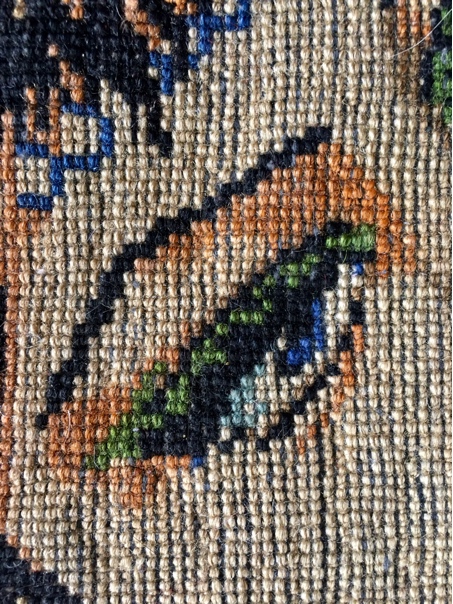
Observing the knots that emplot this rug, this weaver had the artistic talent to improvise a woman's face. Anyone who has ever tried sketching knows that faces are incredibly difficult. A misshapen eye or slightly misapplied nose renders the figure odd looking at best and laughable at worst. Yet this weaver had to conceive of the knotted pattern as she proceeded. The shading on the painter's hand and contouring of the face and ear also demonstrate a level of artistry portraying the weaver's expertise. On each row, she would have made impactful decisions to shape Shirin's visage. In short, the work is an extended innovation—as rugs like this are incredibly rare so the weaver would not have practiced it before—as well as an improvisation, requiring a confidence and ability for sustained successful decision making.
The size and orientation of the rug invite the repetition: a bottom figure and a top figure (see photo for Reader & Contexts above). The bottom figure is more refined, considering the shape and detailing of Shirin's eyes in particular. Comparing the bottom and top halves of the rug, the top section is slightly less assured. For example, Shirin's eye shape and color change, the nose shape changes, and the ear shape and coloring differ. The alignment of the rug overall also shifts, as I discuss in more detail below. Did something change in the weaver's life about halfway through her project? Could this rug tell the story of an apprenticeship, where an older expert weaver created the bottom half and a less experienced weaver worked to replicate it in the top half?
Next, the background of the piece demonstrates the weaver's additional talents in geometric design. The painter's sleeve, visible in the bottom left corner of each depiction, begins an angular pattern that extends into the representation of the mountain and the channel of flowing milk surrounding the portrait. The weaver adapted her work between angles and curves (without a pattern) moving side to side from bottom to top, as the plot of the rug making played out. The weaver demonstrates her skills at creating a visual rhythm in the background that, in contrast with the stillness of the portrait and the implied graceful movement of the hand, reveals an innovative vision. She is able to portray—through the plot of her work—Shirin's narrative (see the detail photo for Symbols & Stylistics above).
Finally, a notable feature of this textile's plot is evidence that the rug was likely moved while still on the loom: in the upper right corner, a 15.25-inch-long section of additional dark blue binding was added to make the rug look squared along the top edge, when it is actually about an inch narrower than it is at the bottom (see the full rug photo). Because the weaver knotted the rug freehand, rather than following a pre-existing pattern, her counts along the top section of the rug shifted because the off-centered nature of the warp affected how the weaver's perception of the rug as she finished the top section. Riyaz explained what may have happened is that the weaver needed to make an annual migration before finishing the project, and as the loom was moved, the warp was pulled off center. Another possibility is that the weaver needed to put this project away for a while to attend to other priorities.
Symbols and Stylistics: Combining traditional tribal motifs along with her own innovative artistry of design and color, the weaver of the Shirin rug demonstrates her mature approach to style. The deep indigo of the border background is a signature color in Balochi textiles. Although Baloch–Taimani rugs typically are more restrained in their palettes, this weaver has a sophisticated eye for variation as she balances the deep blue with softer colors in the border. She has worked deftly with different dyes as well as the raw colors of the wool to create the delicate skin tones, contrasted with the strength of Shirin's green floral dress and long black hair.
Striping designs are another mark of Balochi weaver stylistics (Moheban, 2016, vol. 1, p. 90). Looking at the rug overall, the clear and complicated frame around the portrait demonstrates layers of traditional Balochi design. Such a display of insider technical expertise emphasizes the contrast of the unusual and rather nontraditional content (the portraits) inside the frame. Consider the complex layers of striping, starting from the outside and moving inward:
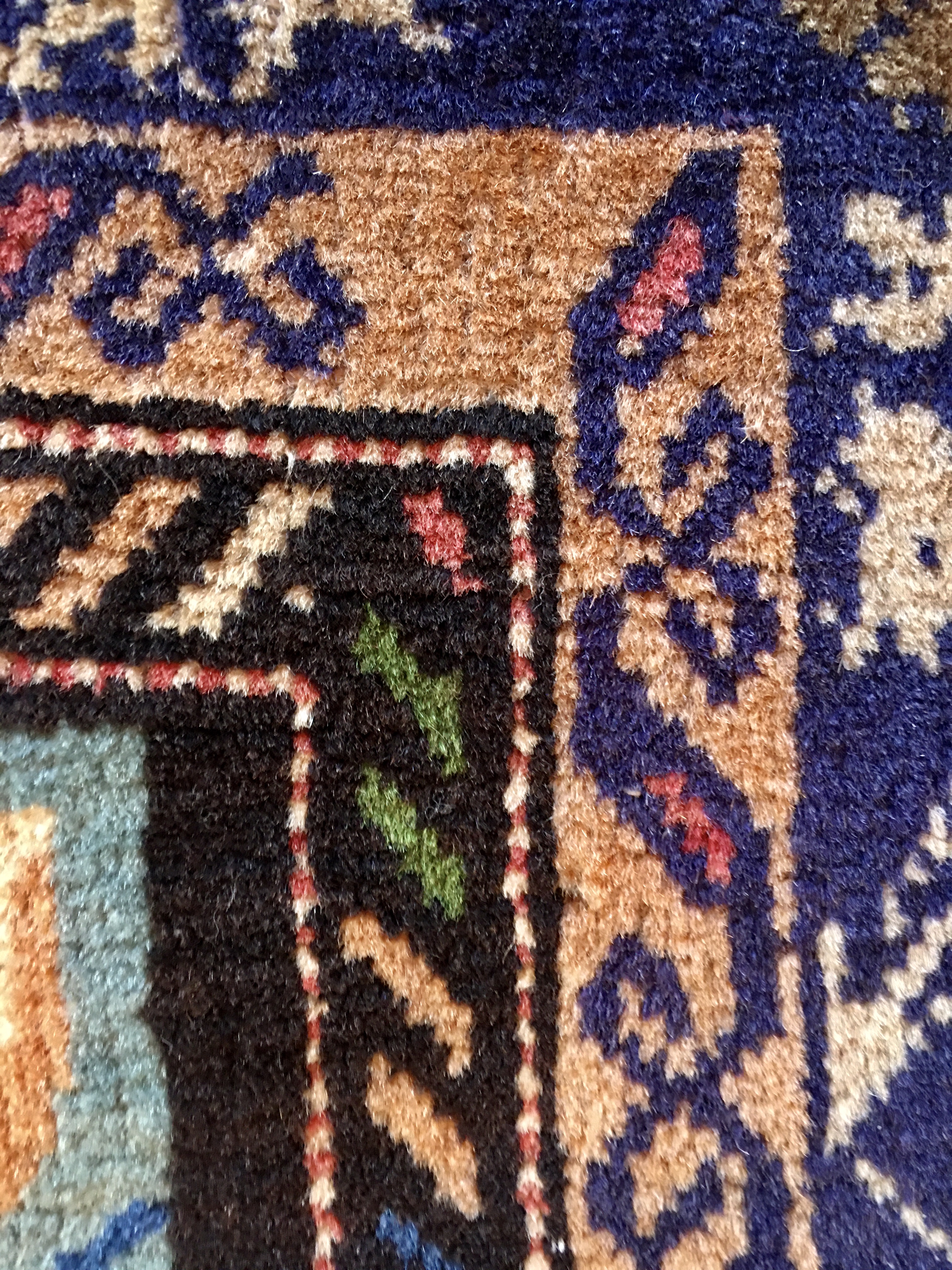
- Innermost, a black outline immediately surrounds the portrait, which is varied in its thickness, heavier on the lower left and thinnest on the lower right.
- Moving outwards towards the edge, a tiny red and white stripe appears, only one knot wide in the vertical sections and one row long horizontally.
- Continuing outward, the next striping effect is the multi-colored border, stylized with colored diagonal stripes in green, white, tan, blue, dark pink, and light pink and outlined in black. Although the striped bars do not follow a pattern of color repetition, they do come in consistent sets of two, with two exceptions. On the upper right corner, a tiny partial dark pink diagonal and the single white bar to its left denote where the weaver had to negotiate the closing of the striped frame. In addition, on the lower left side of the frame are three green diagonals and three tan diagonals. This deviation of number may have been because the weaver chose the wrong color on the third green diagonal's first row, but once the beater locked those knots in place, she could not undo them so she had to problem solve.
- Next is a second repetition of the one knot red and white striping, followed by a black outline of single knots.
- The outward tracing of the stripes is the first of two smaller brown borders containing the blue geometric pattern, highlighted by bits of red. In addition to such geometric striping, the hooks (or small "s" shapes) it contains are common to Balochi weavers.
- The largest striping design is the wide floral border framing for the portrait. The multi-colored flowers are reminiscent of the herati fish pattern common to Balochi style.
- Close to the outer edge is a repetition of the brown geometric hook border.
- Finally, an indigo border, two or three knots wide, forms the two vertical edges. Some may not count this as a stripe.
Noting the sophistication of just the striping work in the border took me several revisits to the rug. I imagine the weaver having to remember these details as she goes because she does not have a written pattern.
Although tempted to read meaning into the weaver's choices of motif—such as the hooked "s" shapes warding off evil—I stop short of proposing what they may mean, as such symbolic interpretations may be little more than "marketplace mythology" (Denny, 2014, pp. 109–110). What we do know, however, is that they are evidence of her familial and tribal belonging as well as demonstration of her expertise.
While the striping and framing tell a story of belonging, inside the frame, the stylistic elements of the portrait speak to intelligent innovation. The combination of geometric and curved patterns representing the mountain and the milk create a feeling of movement, as does the hand in the midst of creating Shirin's portrait. The stylistic result portrays not only the princess protagonist but more fully the story itself. Visual artists have long been motivated by the challenge of creating three–dimensional effects in two–dimensional spaces (a canvas, a photographic print, a projected image), and the weaver here has accomplished that task using approximately 313,000 knots of hand-spun, hand-dyed wool engineered on a home-constructed loom.
The timing of the rug's creation proves interesting in terms of the weaver's symbolic choices. As noted under the Reader & Contexts section, the rug was likely woven in the years just preceding or at the start of the Soviet war on Afghanistan, a period in which women weavers in the Baloch and Turkoman tribes began talking back to the violence of invasion by producing innovative war rugs, which have drawn much previous attention (see Charland, 2011; Deacon, 2012; Elias, 2021; Fayaz, 2015; Mascelloni, 2009; Spooner, 2011). An example of a war rug is pictured on the homepage, highlighted at the bottom of The Rug Man section of this webtext, and briefly identified in the About the Rugs section under the navigation menu. Set in a war zone, the Shirin weaver's living situation was complicated and likely dangerous, yet in this project, she chose content that conveys fantasy. Perhaps the window into Shirin's world symbolizes desire to escape her harsh living conditions, or perhaps the sadness of violence and loss amidst the desire to live ties Shirin's story to the weaver's wartime conditions.
Enacting a method of re-reading to center the weaver and doing the secondary research homework to find the memoir storytelling "coded into" the rugs (Gollihue & Xiong–Gum, 2020) yields a much deeper and multi-dimensional appreciation of the "digital" (Hass, 2007) literacies and rhetorics communicated by this textile. The framework, as applied to this sample, emphasizes the content, plot, and stylistics of the rug; however, applied to another handmade artifact, other aspects such as setting might move to front stage. Contextual information, such as what I have learned about tribal life, women's erasure, and rug commodification, may be easier or more difficult to come by depending on the age and situation of the material item. In the final section, Binding Off, I draw the strands of this Shirin rug reading into a composite story, where an image of the weaver comes into focus, then tack out to consider broader applications of the material-artifact-as-story framework.
